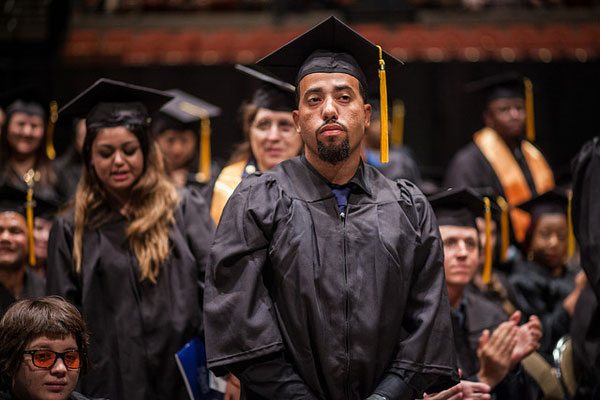
April 30, 2018; Inside Higher Ed
Discussion of higher education often focuses on four-year institutions, but more than six million students a year attend two-year community colleges. And too many of these students fail to receive either associate degrees or certificates. As Ashley Smith writes in Inside Higher Ed, a new report from the Educational Advisory Board (EAB), a Washington-DC based consulting firm, highlights some ways to improve those numbers by redesigning curricula and programs to serve the millions of students who attend part-time in order to balance school, work and family.
While community college impacts all communities—a College Board report notes that, “In fall 2014, 42 percent of all undergraduate students and 25 percent of all full-time undergraduate students were enrolled in community colleges”—these percentages are even higher for Black and Latinx students. While Blacks are 11 percent and Latinx 13 percent of attendees at four-year public universities, for community colleges, those numbers increase to 15 percent for Black students and 22 percent for Latinx students.
The report, titled Reframing the Question of Equity, was released during the national convention of the American Association of Community Colleges. Based on interviews of over 100 community college leaders, the report finds that 84 percent of Latinx students and 81 percent of black students enrolled part-time for at least one term, as do 72 percent of white students.
Pushing students to stay enrolled full time, however, is not a realistic solution, particularly given that overall more than three-in-five community colleges attend part-time.
“We can’t ignore that fact, because that [community college] population is made up of underrepresented [people of color], low-income and first-generation students, and they are disproportionally likely to attend part-time,” notes Christina Hubbard, director of strategic research at EAB and project director for the report. “Full-time is not going to work for every community college student. The data says it won’t work for most students because of barriers. Underrepresented [students of color] and low-income students, they’re more likely to be working. So, to expect them to go 15 credits at a time is setting them up to fail.”
Sign up for our free newsletters
Subscribe to NPQ's newsletters to have our top stories delivered directly to your inbox.
By signing up, you agree to our privacy policy and terms of use, and to receive messages from NPQ and our partners.
So, if promoting full-time status is not the solution, what is? Hubbard notes that there are a number of ways to enhance the part-time student experience. For instance, at City Colleges of Chicago, the school recently changed its tuition structure to charge by credit hour, rather than giving discount rates to full-time students (which, of course, effectively raises the price for part-time students).
At Trident Technical College in South Carolina, pass rates increased when the college made changed its programming schedule by cutting 14-week semesters in half into seven-week terms. “They looked at their own data and saw that students who enrolled in shorter terms had better success rates,” Hubbard explains. “If something catastrophic happens midway through a term…then you withdraw, and you’ve essentially lost the credits you’ve put in.”
“But, as Smith writes, “under a divided semester, if students choose to withdraw after seven weeks, they don’t lose the credits or the work they put into the first chunk of time.”
In 2011, under a 14-week semester, the average course pass rate stood at 61 percent. By 2016, with seven-week terms, the average course pass rate increased to 74 percent. For Black students, pass rates increased from 44 percent to 61 percent during the same five years. And for Pell-eligible students, the pass rates rose from 57 percent in 2011 to 71 percent in 2016.
Laurie Fladd, the associate dean of science and math and director of academic advising at Trident Tech, notes that the school also changed its orientation and advising for part-time students. As Smith explains, “when students apply to the college, they get access to software that takes them through an orientation process. That process doesn’t happen in one hour or one day, or even over a weekend, like many college orientation sessions. Instead, it doles out information piecemeal to the student, depending on where they are in the semester or specific events.”
“We’re advising part-time students the same way we would full-time, but we’re trying to find out their particular life situation and what it is that makes them be part-time,” Fladd explains.—Steve Dubb













